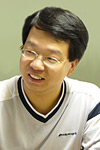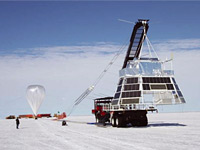 |
|
|
 |
Radio Frequency Control
In many accelerators, particles are accelerated with radio frequency (RF) electromagnetic waves inside cavities. The quality of the acceleration directly depends on the stability of the frequency of the RF wave, which is provided as a pulse of a thousandth of a second. An electron is accelerated in an electric field of a sine curve. When temporal timing changes,

Zhe Qiao Geng worked on software for radio frequency control. |
the bunch size of the electron also changes, as the accelerated energy changes. In the ILC, RF stability must be controlled around 0.3%, and achieving this level of stability, a feedback system to stabilise the frequency using digital technology is essential for the Low Level RF generator (LLRF).
In Comparing RF control to sound, it corresponds to continue making a constant volume of sound at a constant tone. For example, regular tuning is necessary for a piano in order to get a constant tone and volume of sound. On the other hand, RF control can keep making a sound while it is being tuned.
Read more...
-- Nobuko Kobayashi |
 |
|
|
 |
|
Upcoming meetings, conferences, workshops
ILC Perfume Mountain Meeting-What is the role of China and
the International Linear Collider (ILC), a large scientific international project
5-7 December 2006
Beijing, China
Third symposium on large TPC for low energy rare event detection
11-12 December 2006
Carré des Sciences, Paris, France European LC WS Meeting
8-9 January 2007
Daresbury Laboratory, UK
MAC meeting
10-12 January 2007
Daresbury Laboratory, UK
USPAS
Texas A&M University
15-26 January 2007
ILC Detector Test Beam Workshop
Fermilab, Batavia, Illinois
17-19 January 2007
The 9th ACFA ILC Physics & Detector Workshop & ILC GDE Meeting
IHEP, Beijing
4-7 February 2007
Annual WILGA Conference
Warsaw University of Technology Resort, Poland
21-27 May 2007
LCWS 2007
Hamburg, Germany
30 May - 4 June 2007
GDE Meetings Calendar
|
|
 |
 |
|
|
 |
From Outer Space to Inner Tracker: Japanese Magnet on Loan at DESY

Preparations for a balloon flight - EUDET's new magnet has been to space. |
A magnet used in a stratospheric antimatter experiment in Japan is on its way to DESY where it will play an important role in R&D for the ILC detectors. Tobias Haas from DESY reports.
In 1928 Paul Dirac wrote down a most peculiar equation. It was the result of his attempt to combine the two most successful theories of his times, namely Einstein's theory of Special Relativity and Bohr's theory of Quantum Mechanics. The problem was: combining the two theories only made sense if you doubled all known particles. Antimatter was born. Dirac proposed that for each particle there would be an anti-particle—particles that look like exactly like pieces of known "regular" matter, but differ by the sign of their electric charge. When particles and anti-particles meet they annihilate and new particles form out of pure energy. Only four years later the American experimentalist Carl Anderson discovered the positron, the anti-partner of the electron. Dirac's mysterious equation turned out to be a huge success that even got him the Nobel Prize.
Read more...
-- Tobias Haas
Tobias Haas is a physicist in the ZEUS collaboration at DESY and coordinator of a EUDET workpackage.
|
 |
|
|
 |
From Interactions.org
20 November 2006
World's largest superconducting magnet switches on
Read more... |
|
From The American Institute of Physics Bulletin of Science Policy News
17 November 2006
FY 2007 Appropriations Wrap-Up: Short on Time, Short on Money
Read more... |
|
From Physics Web
16 November 2006
X-ray laser focuses on tiny objects
Read more... |
|
From Science
15 November 2006
The Ultimate "Flash Photography"
Read more... |
|
From American Physical Society
5 November 2006
Statement On The International Linear Collider
Read more... |
|
From symmetry Magazine
October/November 2006
Close Quarters
Read more... |
|
|
 |
The Japanese Strategy of High-Energy Physics: Full Support for the ILC
Today's issue features a Director's Corner from Mitsuaki Nozaki, GDE Asian Regional Director.

Japan discusses the future of particle physics. |
A community-wide consensus is inevitable to promote a big project like the International Linear Collider, otherwise the project will not be supported by other science disciplines and governments. The US and European communities have set out their strategies for particle physics and presented their plans and prioritised their projects.
The Japanese community has also discussed its future plan. In 2008, the integrated luminosity of the KEK B factory is expected to reach its present goal of 1 ab-1 and the construction of J-PARC, the next major accelerator in Japan, will be completed. Under these circumstances, it is urgent for us to make the next plan for the upcoming decade.
Read more...
-- Mitsuaki Nozaki
Director's Corner Archive |
 |
|
|
 |
Early Edition of NewsLine This Week
Due to the Thanksgiving Holiday in the United States this Thursday, the ILC Communicators are sending you an early edition of ILC NewsLine this week. The publication will return to its normal schedule next week. |
|
| The joint ACFA/GDE meeting will be held in Beijing, China on 4-7 February 2007. The deadline to register is 1 December, and abstracts should be submitted by 31 December. To learn more about the meeting, go online. |
|
ILC-Related Preprints
hep-ph/0611222
21 Nov 2006
Lepton flavour violating processes at the International Linear Collider
hep-ph/0611240
17 Nov 2006
Decay of Charged Higgs boson in TeV scale supersymmetric seesaw model
hep-ph/0611211
16 Nov 2006
The light pseudoscalar Higgs boson in NMSSM |
|
|

